Week 4 Y6 English Trial Test
Quiz Summary
0 of 30 Questions completed
Questions:
Information
You have already completed the quiz before. Hence you can not start it again.
Quiz is loading…
You must sign in or sign up to start the quiz.
You must first complete the following:
Results
Results
0 of 30 Questions answered correctly
Your time:
Time has elapsed
You have reached 0 of 0 point(s), (0)
Earned Point(s): 0 of 0, (0)
0 Essay(s) Pending (Possible Point(s): 0)
Categories
- Not categorized 0%
| Pos. | Name | Entered on | Points | Result |
|---|---|---|---|---|
| Table is loading | ||||
| No data available | ||||
- 1
- 2
- 3
- 4
- 5
- 6
- 7
- 8
- 9
- 10
- 11
- 12
- 13
- 14
- 15
- 16
- 17
- 18
- 19
- 20
- 21
- 22
- 23
- 24
- 25
- 26
- 27
- 28
- 29
- 30
- Current
- Review
- Answered
- Correct
- Incorrect
-
Question 1 of 30
1. Question
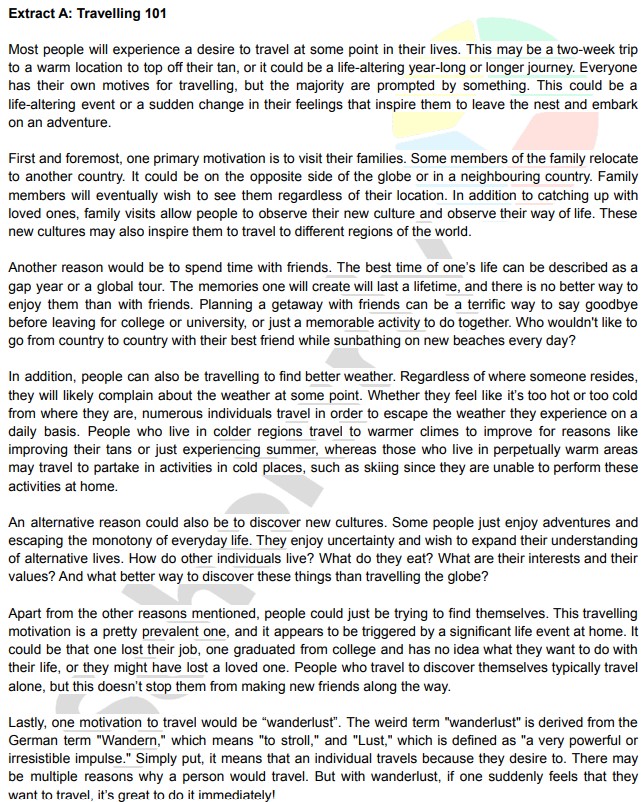
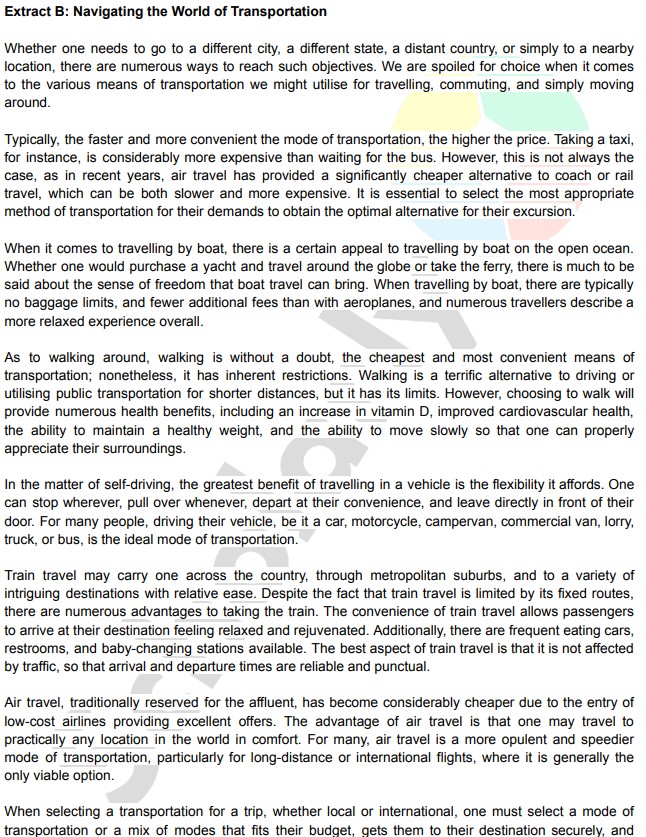

1 What is the main purpose of extract A as opposed to extract B?
A. Extract A describes the history and evolution of travelling while Extract B explains the culturalsignificance of travelling.
B. Extract A focuses on the various modes of transportation and their drawbacks while Extract Btries to persuade individuals to travel more frequently.
C. Extract A explains the different aspects of travelling and why it is important while Extract Bhighlights the negative consequences of travelling.
D. Extract A aims to inform about the reasons why individuals travel whereas Extract B aims toexamine the different types of transportation and their advantages.CorrectIncorrect -
Question 2 of 30
2. Question



2 How are the two extracts different in terms of what they cover?
A. Extract A and Extract B both discuss the pros and cons of different forms of transportation, suchas air travel and cruise ships.
B. Extract A and Extract B both discuss the role of technology in enhancing the travel experience,such as the use of online booking platforms.
C. Extract A and Extract B both explore the impact of travel on mental and physical well-being,such as reducing stress levels and promoting personal growth.
D. Extract A discusses elements that influence a person’s decision to travel, such as culturalimmersion, whereas Extract B discusses modes of conveyance, including walking and driving.CorrectIncorrect -
Question 3 of 30
3. Question



3 Which of the following are facts gathered from the two extracts?
I. Everyone travels for different reasons, but the majority are prompted by something.
II. At some point, people will undoubtedly moan about the weather regardless of where they live.
III. The greatest advantage of driving one’s own automobile is the freedom it gives.
IV. The ease of rail travel enables people to arrive at their destination feeling refreshed and
relaxed.A. III, II and I
B. II, IV and III
C. All of the above
D. None of the aboveCorrectIncorrect -
Question 4 of 30
4. Question



4 The fifth paragraph of extract A states that travelling can also help someone escape themonotony of daily life. What does this idea mean?
A. Travelling restricts individuals to routine and limits new adventures.
B. Travelling allows individuals to break free from routine and embrace new adventures.
C. Travelling does not affect an individual’s daily routine and does not allow for new adventures.
D. Travelling encourages individuals to continue with their daily routine and dismiss newadventures.CorrectIncorrect -
Question 5 of 30
5. Question



5 Upon reading the extracts, what factors should one consider when choosing the bestmode of transportation for their trip?
A. Whether the transportation is eco-friendly should be the only consideration when choosing themode of transportation.
B. Take into account financial constraints, and the final destination, and ensure a comfortable andsafe journey.
C. One should only consider the speed and convenience of the mode of transportation, regardlessof cost.
D. The type of vehicle one wants to use for their trip is the only factor that matters.CorrectIncorrect -
Question 6 of 30
6. Question



6 The following are themes evident in the two extracts except?
A. Environmental effects
B. Adventure and exploration
C. Discovery
D. Personal experienceCorrectIncorrect -
Question 7 of 30
7. Question


7 What is the speaker’s attitude towards the house and its inhabitants?
A. The speaker has a cheerful and joyful attitude towards the house and its inhabitants.
B. The speaker has a curious and frustrated attitude towards the house and its inhabitants.
C. The speaker has a calm and peaceful attitude towards the house and its inhabitants.
D. The speaker has a fearful and apprehensive attitude towards the house and its inhabitantsCorrectIncorrect -
Question 8 of 30
8. Question


8 What is the significance of the leaf-fringed sill in line 10?
A. It symbolises the decay and neglect of the house and its surroundings.
B. It reflects the speaker’s sense of detachment from the world around him.
C. It serves as a metaphor for the speaker’s relationship with the house and its inhabitants.
D. It represents the organic and natural world surrounding the house, contrasting with the stillnessand emptiness within.CorrectIncorrect -
Question 9 of 30
9. Question


9 Why does the speaker repeatedly call out to see if anyone is home?
A. To see if anyone is home because he is lost and needs directions to his destination.
B. To see if anyone is home because he wants to spread a message of fear and terror to theinhabitants.
C. To see if anyone is home because he wants to rob the house and steal their possessions.
D. To see if anyone is home because he is seeking human connection and desires to find someoneto talk to in an unfamiliar place.CorrectIncorrect -
Question 10 of 30
10. Question


10 What do lines 13-14 reveal about the people living in the house?
A. They are absent and do not occupy the house.
B. They are kind and loving.
C. They are wealthy and live a luxurious lifestyle.
D. They are sweet and welcoming.CorrectIncorrect -
Question 11 of 30
11. Question


11 What is the significance of the speaker’s departure at the end of the poem?
A. It signifies the speaker’s newfound happiness and contentment with their surroundings.
B. It symbolises the speaker’s decision to stay and make the house their permanent residence.
C. It underscores the speaker’s sense of loneliness and solitude, emphasising their feeling ofdisconnection.
D. It represents the speaker’s realisation that they will find the connection they seek in this worldwhen they grow older.CorrectIncorrect -
Question 12 of 30
12. Question


12 The repetition of the first words of lines 3, 5 and 7 is an example of what poetic device?
A. Synecdoche
B. Anaphora
C. Onomatopoeia
D. MetonymyCorrectIncorrect -
Question 13 of 30
13. Question

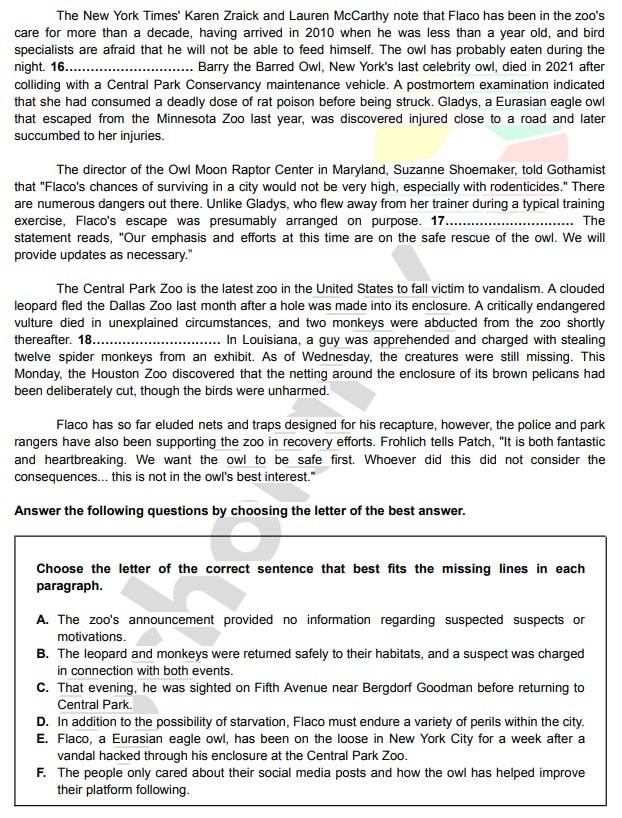
 CorrectIncorrect
CorrectIncorrect -
Question 14 of 30
14. Question


 CorrectIncorrect
CorrectIncorrect -
Question 15 of 30
15. Question


 CorrectIncorrect
CorrectIncorrect -
Question 16 of 30
16. Question


 CorrectIncorrect
CorrectIncorrect -
Question 17 of 30
17. Question


 CorrectIncorrect
CorrectIncorrect -
Question 18 of 30
18. Question


 CorrectIncorrect
CorrectIncorrect -
Question 19 of 30
19. Question
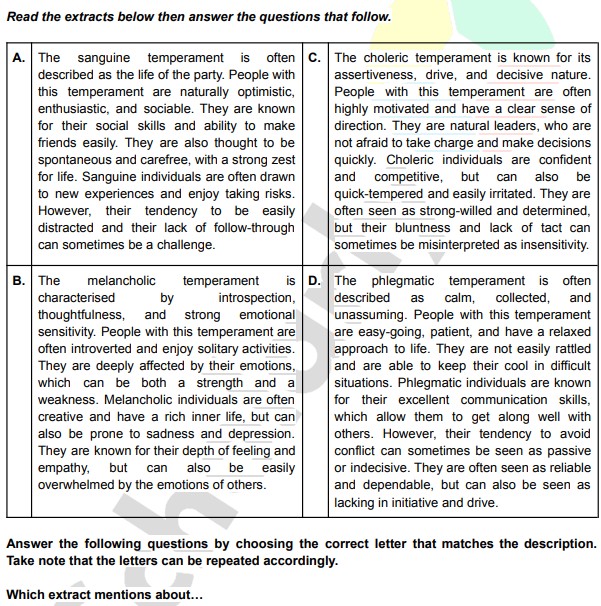
19. a personality temperament wherein individuals enjoy taking chances and are characterised asadventurous and daring?
CorrectIncorrect -
Question 20 of 30
20. Question

20. a personality temperament wherein individuals are described as irritable and bold, but can alsobe unsympathetic and frank?
CorrectIncorrect -
Question 21 of 30
21. Question

21. a personality temperament wherein individuals are positive and energetic but may quickly lackfocus?
CorrectIncorrect -
Question 22 of 30
22. Question

22. a personality temperament wherein individuals are depicted as peaceful and happy-go-lucky,but may also be tolerant and doubtful?
CorrectIncorrect -
Question 23 of 30
23. Question
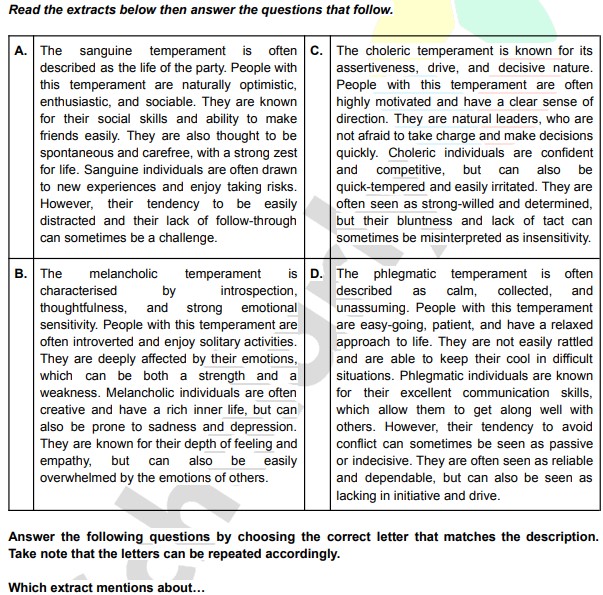
23. a personality temperament wherein individuals are presented as timid, keen, and reflective, butmay also be inclined to sorrow and misery?
CorrectIncorrect -
Question 24 of 30
24. Question

24. a personality temperament wherein individuals are composed and can maintain theircomposure in challenging circumstances?
CorrectIncorrect -
Question 25 of 30
25. Question
Read the article below then answer the questions that follow.
Who Made the First Stone Tool Kits?
The deceased hippopotamus was a stroke of good fortune for our ancient human ancestors. Three million years ago, such a large animal promised a vast supply of fat-rich food to the people living on the shores of Lake Victoria in Africa. And the hungry crew understood precisely how to capitalise. They began working on the beast with the antique stone tools they had fashioned by hand. Since the site predates the widespread use of fire by around two million years, it is possible that they chopped and pounded the meat into a type of hippo tartare.
The recent discovery of the bones and tools left behind from this and another hippo butchering at Nyayanga, on Kenya’s Homa Peninsula, has altered our view of how human tool use evolved. Scientists hailed this site as the oldest known instance of Oldowan toolmaking, a revolutionary advance in the sophistication of stone implements and the jobs they could be employed for. The tools from the site are 300,000 years older than the previously earliest known specimen of Oldowan.
And two molars from the extinct human genus Paranthropus found at the site pose a mystery: who fashioned and utilised these implements? Oldowan technology is commonly identified with our own genus Homo, the origins of modern humans. The discovery, however, shows that our large-toothed, small-brained Paranthropus relatives may have fashioned rocks for their own use or co-opted them from Homo contemporaries who also resided in East Africa during this crucial evolutionary period when the two lineages diverged.
According to anthropologist Rick Potts, head of the Human Origins Program at the National Museum of Natural History, “what we’re actually talking about with the beginning of the Oldowan is the commencement of toolmaking as a regular practice in human evolution. At this moment in evolution, we can finally declare that stone toolmaking is something that persists, spreads, and proliferates.” Potts is a co-author of the study, in which scientists from a variety of institutions, including the National Museums of Kenya, participated.
According to the study, excavations in Nyayanga near the shores of Lake Victoria have uncovered 330 stone objects and 1,776 animal bones since 2015. Studies of these bones under a microscope revealed the unique signs of cutting, scraping, and hammering created when stone tools are used to butcher an animal. The bones of the two hippos, which were discovered beside the tools used to butcher them, are the earliest evidence of humans preparing and consuming such big creatures.
The scientists also examined the ancient stone tools’ microscopic wear patterns. By recreating the old wear with a new set of stone implements, they determined the types of hits and blows that caused it. Using these tools, the scientists hacked, smashed, and sliced numerous plant materials that would have been found in the region, including soft passion fruits, pulpy and fibrous cassava, woody barks and roots, and underground tubers such as yams. The re-enactors wear patterns matched those found on the archaic tools, suggesting that the originals were used to prepare a variety of animal and plant-based foods. Whoever they were, these individuals probably ate whatever was available, and their adaptability, aided by the tools, may have been crucial to their survival and evolutionary progress.
The stone tools of Nyayanga are not the oldest ever discovered. Approximately 3.3 million years ago, at a site called Lomekwi 3 on the western bank of Lake Turkana in northern Kenya, ancient humans purposefully smashed one stone against another to break off shards. The earlier tools are larger, more basic rock fragments, indicating a less sophisticated origin. They may have been utilised similarly to how chimpanzees utilise stones to crack open nuts.
Who were these first adaptive toolmakers, exactly? This question is challenging to answer. For decades, scientists widely believed that individuals of our genus, Homo, would have taken the cognitive leap to build tools—it was considered a vital step on the route to becoming modern humans. The 3.3-million-year-old Lomekwi 3 tools predate the first known Homo species, although they are rough and basic compared to the Oldowan implements.
Common scientific belief holds that because Homo had small teeth, they resorted to toolmaking to improve their ability to digest a variety of meals. In fact, Homo is the species that ultimately developed larger brains and became the prehistoric world’s major manufacturer of stone tools. Paranthropus, on the other hand, expanded their diet in a different way. They evolved large teeth and robust jaws to break down harder items like nuts and roots into more edible forms. After their separation, the two lineages appear so dissimilar that it is doubtful that they occupied the same ecological niche. Obviously, none of these limits the possibility that Paranthropus also made tools.
This finding, according to Potts, demonstrates that the innovation in tool technology that enabled Homo lineages to adapt, survive, and evolve into modern humans has an older origin and was more widely dispersed across Africa. However, he is aware that the sight of these two enormous molars may prompt people to question who initiated the conflict. Potts adds, “It’s strange how Paranthropus continues rearing its head or fangs wherever there is Oldowan technology.” What are these Paranthropus teeth doing at this site? We do not know the answer, thereby reopening the issue, “Who was the first toolmaker?”
Answer the following questions by choosing the letter of the best answer.
 CorrectIncorrect
CorrectIncorrect -
Question 26 of 30
26. Question

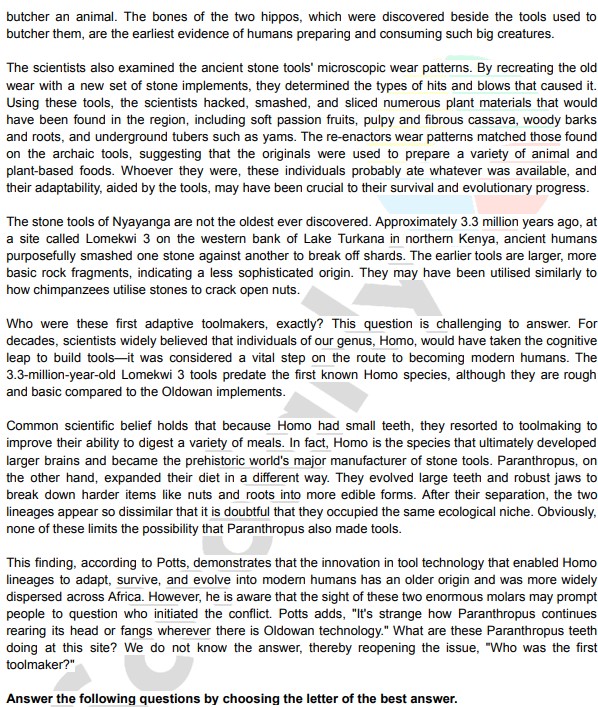
26 What was the significance of the finding of bones and tools near Lake Victoria in Africa at Nyayanga?
A. It altered perspectives on the evolution of human tool utilisation.
B. It was a minor discovery that did not contribute to the community’s understanding of evolution.
C. It had no significance as the bones and tools were from an extinct species that was not related
to the evolution of modern humans.
D. It only confirmed previously held beliefs about human tool use and did not provide new information.CorrectIncorrect -
Question 27 of 30
27. Question


27 Based on the article, how did the scientists determine the type of work the ancient stonetools from Nyayanga were used for?
A. The scientists consulted ancient texts to see what they said about the tools.
B. The scientists evaluated the indications like scuffing and pounding as well as the wear patterns.
C. The scientists estimated the weight of the tools to determine their purpose.
D. The scientists used old tools to see if they could recreate the same marks as the ancient tools.CorrectIncorrect -
Question 28 of 30
28. Question


28 What was the difference in the way Paranthropus and Homo evolved their diets?
A. Paranthropus evolved large teeth for biting and chewing soft foods, while Homo evolved tools touse to chew harder foods with smaller teeth.
B. Homo evolved large jaws and teeth for chewing tough food, while Paranthropus made tools toaccess a wider range of food despite having smaller jaws and teeth.
C. Paranthropus evolved tough jaws and large teeth for chewing tough food while Homo madetools to eat a wider range of food despite having smaller teeth.
D. Both Paranthropus and Homo evolved tools to use in accessing food, but Paranthropus focusedon using tools for cooking while Homo focused on using tools for biting and chewing.CorrectIncorrect -
Question 29 of 30
29. Question


29 What does the head of the Human Origins Program at the National Museum of NaturalHistory think about the discovery at Nyayanga?
A. He is uninterested in the discovery at Nyayanga and sees no significance in it.
B. He believes the discovery at Nyayanga has no relation to human evolution or the developmentof early stone tool technology.
C. He is keen on comprehending the impact of such a discovery on comprehending humanevolution and the growth of early stone tool technology.
D. He considers the discovery at Nyayanga only has significance for archaeologists and not for thescientific community studying human evolutionCorrectIncorrect -
Question 30 of 30
30. Question


30 What is the main goal of the article about the first stone tool kits?
A. To analyse the political and social implications of such a discovery.
B. To provide a list of facts and statistics about the discovery of the first stone toolkits.
C. To disprove the future of human evolution and technology based on the discovery of the firststone toolkits.
D. To describe the process and implications of such a discovery in the context of the study ofhuman evolution and the early development of stone tool technologyCorrectIncorrect